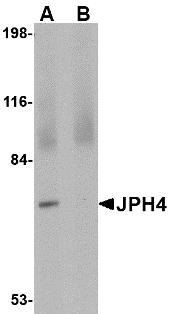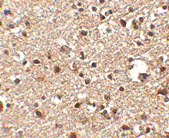Catalog#:4923
Junctional complexes between the plasma membrane (PM) and endoplasmic/sarcoplasmic reticulum (ER/SR) are a common feature of all excitable cell types and mediate cross talk between cell surface and intracellular ion channels. Junctophilins (JPs) are important components of the junctional complexes. JPs are composed of a carboxy-terminal hydrophobic segment spanning the ER/SR membrane and a remaining cytoplasmic domain that shows specific affinity for the PM. Four JPs have been identified as tissue-specific subtypes derived from different genes: JPH1 is expressed in skeletal muscle, JPH2 is detected throughout all muscle cell types, and JPH3 and JPH4 are predominantly expressed in the brain. In the CNS, both JPH3 and JPH4 are expressed throughout neural sites and contribute to the subsurface cistern formation in neurons. Mice lacking both JPH3 and JPH4 subtypes exhibit serious symptoms such as impaired learning and memory and are accompanied by abnormal nervous functions.
Additional Names: JPH4 (CT), Junctophilin 4, JPHL1, hJP-4

Description
Left: Western blot analysis of JPH4 in 293 cell lysate with JPH4 antibody at 1 µg/ml in (A) the absence and (B) the presence of blocking peptide.
Below: Immunohistochemistry of JPH4 in human brain tissue with JPH4 antibody at 2.5 µg/ml.
Other Product Images

Description
Left: Western blot analysis of JPH4 in 293 cell lysate with JPH4 antibody at 1 µg/ml in (A) the absence and (B) the presence of blocking peptide.
Below: Immunohistochemistry of JPH4 in human brain tissue with JPH4 antibody at 2.5 µg/ml.
Other Product Images

Source:JPH4 antibody was raised against a 16 amino acid peptide near the carboxy terminus of human JPH4.
Purification: Affinity chromatography purified via peptide column
Clonality and Clone: This is a polyclonal antibody.
Host: JPH4 antibody was raised in rabbit.
Please use anti-rabbit secondary antibodies.
Application: JPH4 antibody can be used for detection of JPH4 by Western blot at 1 – 2 µg/ml.
Tested Application(s): E, WB, IHC
Buffer: Antibody is supplied in PBS containing 0.02% sodium azide.
Blocking Peptide:Cat.No. 4923P - JPH4 Peptide
Long-Term Storage: JPH4 antibody can be stored at 4ºC, stable for one year. As with all antibodies care should be taken to avoid repeated freeze thaw cycles. Antibodies should not be exposed to prolonged high temperatures.
Positive Control:
1. Cat. No. 1210 - 293 Cell Lysate
Species Reactivity: H, M, R
GI Number: 33585440
Accession Number: AAH55429
Short Description: (CT) T tubule, SR membrane, sarcoplasmic reticulum
References
1. Takeshima H, Komazaki S, Nishi M, et al. Junctophilins: a novel family of junctional membrane complex proteins. Mol. Cell. 2000; 6:11-22.
2. Kakizawa S, Kishimoto Y, Hashimoto K, et al. Junctophilin-mediated channel crosstalk essential for cerebellar synaptic plasticity. EMBO J. 2007; 26:1924-33.
3. Nishi M, Sakagami H, Komazaki S, et al. Coexpression of junctophilin type 3 and type 4 in brain. Brain Res. Mol. Brain Res. 2003; 118:102-10.
4. Moriguchi S, Nishi M, Komazaki S, et al. Functional uncoupling between Ca2+ release and afterhyperpolarization in mutant hippocampal neurons lacking junctophilins. Proc. Natl. Acad. Sci. 2006; 103:10811-6.

No comments:
Post a Comment